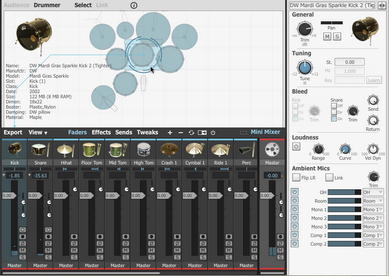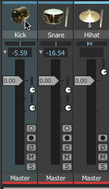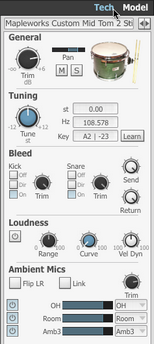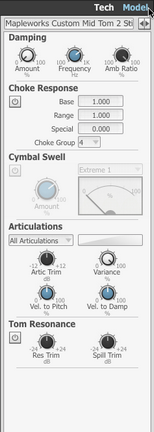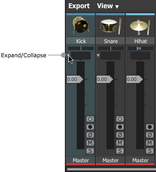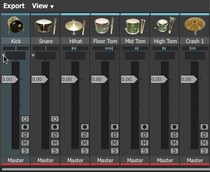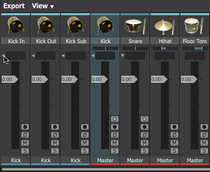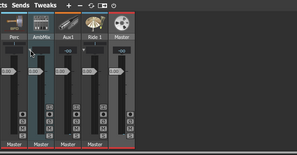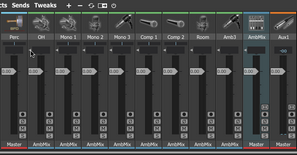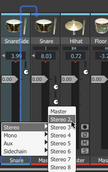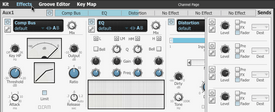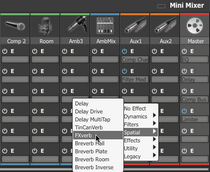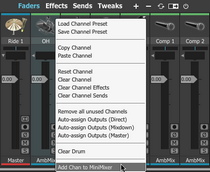Once you've assembled a kit in BFD3 using the Browser (see the previous chapter), you're free to manipulate the sounds using the extensive Drum modelling and mixing engine.
This section provides an overview for using BFD3's audio engine. The subsequent sections throughout this chapter go into more detail about each part of the interface.
1. Drum slots and selection
|
Central to BFD3 is the concept of selection - selecting a Drum slot results in showing its adjustable parameters in the Drum Editor. Selecting a Drum slot in the Kit display Click a Drum slot in the Kit display to select it. Selecting Drum slots is central to many functions in BFD3. As described in the previous chapter, the selected slot is used as the target destination slot for loading Drums from the browser via double-click. If the slot already contains a loaded Drum, its contents are shown in the Drum Editor when selected.
|
|
Selecting a mixer channel Clicking a mixer channel to select it. If a channel is associated with a Drum - a Drum channel or one of its mic sub-channels - it is also selected as the current Drum slot, and its contents are displayed in the Drum Editor.
The differences between Drum slots and mixer channels While some mixer channels represent Drum slots, this is not true of all mixer channels, such as Ambient or Aux channels for example. The currently selected Drum slot is effectively the last Drum slot that was selected. |
See the Kit display section for further details on using the Kit display panel to manage slots and use the Link function for Drum layering.
2. Using the Drum Editor
The Drum Editor contains a comprehensive set of tools to adjust the sound and response of the Drum in the currently selected slot. It is divided into 2 pages - the Tech page features 'drum tech'-oriented functions, while the Model page's functions deal with modelling real-world kit behaviour. Click the Tech or Model buttons to show the panel if it is currently hidden. The following controls are described in full detail in the Drum Editor section.
Tech page
|
General & Tuning The Trim and Pan controls allow you to change the overall level of the Drum and the panning of its direct mic channels within the stereo field. Each Drum also features Mute and Solo buttons. The Tuning function changes the pitch of the Drum. Bleed and Ambient Mics These controls relate to certain mic channels for the each Drum which are mixed with signals from other Drums before the mixer. These controls allow you to adjust levels and other aspects of these signals - bleed can be disabled or routed to the Drum's own mixer channel while Ambient mic signals can be routed to discrete Aux channels if you wish. Loudness The Loudness functions allow you to adjust the dynamic response of the Drum. BFD3's drum sounds are recorded at a wide variety of velocities (striking intensity) - adjusting these settings can drastically alter the feel and sound of drum performances. The Velocity Dynamics control scales the velocity of incoming events (from MIDI notes or from the Groove engine) - in effect, making the 'drummer' play the kit with more or less intensity. The Curve control alters the velocity response of incoming events to the Drum from the default linear 1:1 mapping. The Dynamic Range control introduces amplitude scaling to increase or decrease the dynamic range (the difference in level between the quietest and loudest layers) of the Drum's velocity layer range. |
Model (Modelling) page
|
Damping/Hihat Tighten The Damping section lets you reduce the decay time of a Drum. For basic damping, simply increase the Damping Amount control as desired. The Hihat Tighten controls (available only for the hihat slot) achieve a similar result, except that only the closed articulations of hihats are affected. Choke Response This set of controls provides adjustment over the choking behaviour of a Drum - in other words, how a preceding event for the Drum decays when a new event is triggered. Tom resonance and Cymbal Swell The modelled functions in BFD3 use dedicated synthesis in order to recreate certain properties of a drumkit. The Tom Resonance function creates the sympathetic resonance generated by toms when other toms, kicks and snares are struck. When the Cymbal Swell function is activated, additional shaping is applied to cymbal articulations when played rapidly in succession to simulate their real-world behaviour. Articulations This section offers level control and more advanced velocity-related functions for individual articulations. It also contains the Variance control - this adjusts the degree to which articulations are affected by the AMG (Anti-MachineGun) functions in BFD3's Dashboard panel. By default, these controls are applied to All Articulations - as indicated by the drop-down menu - so the entire Drum is affected. |
3. Using the Mixer and Effects
Channel types
BFD3's mixer contains a number of different types of channels.
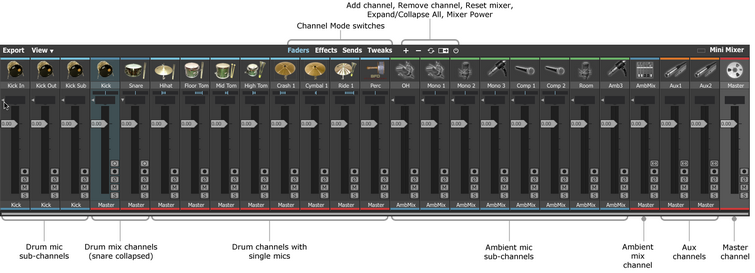
Drum channels
|
Drum channels are the basic building blocks in BFD3's mixer - they can be considered in the same way as recorded drum tracks. A Drum channel represents a Drum slot and its direct microphone channel(s) and can take the following forms:
•A Drum Mix channel fed by a mix of Drum mic sub-channels The first Kick and Snare slots exist in this form. •A single direct microphone channel Hihat, Tom, Cymbal, Percussion and further Kick/Snare slots
|
Using the Kick 1 and Snare 1 channels
|
|
Click the Expand/Collapse button to show the mic channels within the Kick or Snare channel. |
Click the Expand/Collapse button again on any of the mic sub-channels or the parent Mix channel to return it to a single mixer channel. |
Each mic sub-channel can be treated individually, from basic adjustment of the level and pan controls to using effects and sends for processing. If you prefer, these channels can be routed to other Aux channels instead of their parent Kick or Snare channel.
Auditioning Drum channels
Drum channels feature an audition function for auditioning the main articulation of the Drum loaded within them - ALT-click the image at the top of the channel to preview its main articulation.
Ambient channels
Ambient mic channels appear in the mixer in a similar way to Kick and Snare mic channels - they are comprised of an Ambient Mix channel fed by a mix of Ambient mic sub-channels.
|
|
Click the Expand/Collapse button to show the ambient mic channels within the Ambient Mix channel. The Ambient Mix channel is selected in this example. |
Click the Expand/Collapse button again on any of the Ambient mic sub-channels or the parent Ambient Mix channel to return it to a single mixer channel. |
Each Ambient mic sub-channel is a mix of the Ambient mic channels of that type from all Drums in the current kit: for example, the OH channel is a mix of all Drums' Overhead mic channels.
All sounds compatible with BFD3 contain at least 3 sets of stereo ambient mics - OH (OverHead), Room and Amb3 (usually a set of PZM boundary mics or a room mic set further back than the Room set). Some Drums feature additional mono room and compressed direct channels which appear as numbered Mono and Comp channels.
Adjusting the Ambience Mix channel's level effectively sets the 'wet' level of the overall mix.
Note that the Drum Editor's Ambient Mics section allows powerful control over each Drum's Ambient mic channels - it is possible to independently set levels and also to route Ambient mic channels to Aux channel destinations rather than the default routing to the corresponding Ambient channel in the mixer.
Aux channels
|
Aux channels, 2 of which exist in the default BFD3 mixer layout, can be considered in the same way as a 'buss' or a 'group' on a mixing console. Any number of signals can be routed to an Aux channel, from the following sources:
•Drum and Ambience mixer channels The entire output of one or more mixer channels can be routed to an Aux channel using their Output selector controls for sub-mixing before further routing afterwards. Alternatively, a variable amount of one or more mixer channels can be routed to an Aux channel in parallel using the Send controls. The Output selector and other mixer channel controls are discussed in detail in the Mixer controls section later in this chapter.
|
•Drum Editor
The controls in the Ambient Mics section of the Drum Editor allow individual Drums' Ambient mic channels to be sent to Aux channels for discrete processing.
In actual fact, the Kick, Snare and Ambient mix channels are special Aux channels to which the Kick, Snare and Ambient sub-mics are routed via their Output selector controls. However, even if their sub-mics are routed to other destination channels or outputs, the Expand/Collapse buttons still toggle their visibility in the mixer.
Master channel
The Master channel is, by default, the eventual Output destination for all channels in BFD3. It is effectively a special Aux channel that is hard-wired to the primary stereo output of the BFD3 plugin.
As mentioned above, channels can be sub-mixed into other Aux channel 'stems'. Alternatively, channels can be routed outside BFD3 using its multiple sub-outputs.
Of course, a combination of all these approaches can be used.
Routing channels to plugin outputs for further external processing
|
The Output selector control at the bottom of each channel lets you route any channel to one of BFD3's multiple sub-outputs. This routing can occur at any stage of the mix - individual Drum mic channels can be routed externally to do all your mixing with plugins in your DAW or outboard gear, or some sub-mixing using Aux channels can be conducted first within BFD3, with the Aux channels being routed to external outputs. Shortcuts for sequential output assignment The mixer channel context menu, displayed by right-clicking on any channel, offers shortcuts for simple sequential output assignment. To conduct all mixing and processing of mic signals outside BFD3, use the Auto-Assign outputs (Direct) function on the mixer's channel context menu. Use the Auto-Assign outputs (Master) function to return to the default output assignments. |
Using the built-in mixing functions, FX and Sends
|
Selecting a Mixer channel results in showing its contents in the Effects Editor. This panel displays the channel's 6 effect slots and 4 Sends which operate in a very similar way to those found in most DAWs - see the Effects and Sends section for a detailed guide. This panel and the Kit display cannot be viewed simultaneously. Use the Effects and Kit buttons in the navigation bar to switch between them. |
4. Mixer channel modes
The mixer features 4 modes, activated by the Channel Mode switches: the Faders, Effects, Sends and Tweaks buttons above the mixer. Each mode shows a different set of controls on each mixer channel.
Faders channel mode
The Faders mode is the default, and displays controls regularly found on mixer channels, most of which should be familiar to you already. See the Mixer channel controls section for full details of all the controls.
Tweaks channel mode
The Tweaks channel mode offers varying types of controls for each channel, depending on the channel type. The most important functions are described below - see the Mixer channel controls section for details of all controls.

Drum channels
Drum Mix channels feature Tune, Trim and Damp (Damping amount) controls in Tweaks mode. These parameters are also found in the Drum Editor but are provided within the mixer for convenience and and overview of multiple channels' settings.
Ambient channels
The Distance control adjusts the distance of each pair of ambience mics from the kit. This control effectively introduces a delay between the relevant set of ambient mics and the direct mic signals.
The Width control (available only on stereo channels such as OH (Overhead), Room and Amb3) adjusts the stereo width of the channel between mono (especially useful for powerful, fat room sounds), stereo at the centre position and expanded stereo at the fully clockwise position.
|
Effects and Sends channel modes The Effects channel mode displays all channels' Effect insert slots, allowing an overview of multiple channels' Effect slots simultaneously. Effect devices cannot be edited directly in this mode - devices can be only inserted and powered on/off. Clicking the E (Edit) button for a slot takes you directly to the device within the Effects Editor. See the Effects/Sends modes section for more details of these controls. The Sends channel mode shows all controls for the channel's 4 Sends. The controls are smaller versions of all the controls in the Sends panel in the Effects Editor. |
5. Other mixing functions and exporting audio
Minimixer
|
The Mini Mixer displays any combination of often-used mixer channels within a panel visible at the right side of the mixer. Click the Mini Mixer button to toggle its visibility. Any channel(s) can be added to the Mini Mixer using the channel context menu - simply right-click on any channel and use the Add Chan to Mini Mixer function. See the Mixer controls section for more details on using the Mini Mixer. In the example below, the Overhead, Room, Amb3 and Master channels have been added to the Mini Mixer so they are always visible. |
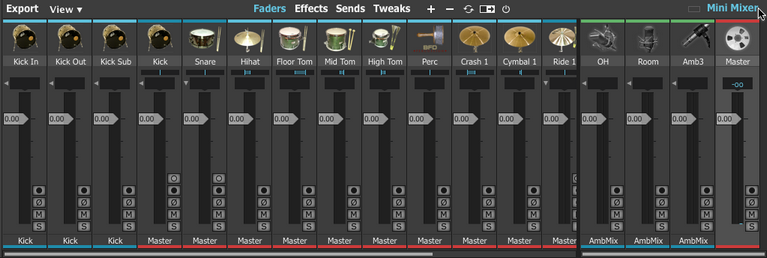
Mixer toolbar
The toolbar above the mixer features a number of controls for managing mixes - see the Mixer controls section for a guide to these controls.
Export panel
BFD3 allows you to export audio directly to disk using the controls in the Export panel. These functions are useful for creating drum recordings using the BFD3 standalone application, or they may be more convenient for creating multi-channel mixdowns than your host/DAW. See the Exporting audio section later in this chapter for more details.
